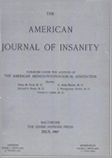Abstract
(1) Contrary to many previous reports, the majority of the patients of this series were found to have manic-depressive psychoses, a large number were cases of dementia præcox, and only 3.6 per cent were considered to be toxic-exhaustive deliria. The tendency in the last decade seems to have been to classify fewer of these cases as "psychosis with other somatic disease," as apparently the great majority vary little if at all from the usual pictures of the non-puerperal psychoses.
(2) The present writer failed to find as high a proportion of the depressive type of manic-depressive psychoses as did Kilpatrick and Tiebout8, although this was the most frequent type in the series studied. Also, their finding that the presence of physical factors related to childbirth makes for more frequent confusion in the depressive type was not substantiated.
(3) Contrary to Kilpatrick and Tiebout's8 finding that puerperal schizophrenias are all of paranoid reaction, this study shows a greater number of catatonics than of the paranoid type.
(4) The writer failed to substantiate the claim of Strecker and Ebaugh8 that something is added to the ordinary symptomatology of puerperal manic-depressive psychoses by the intrusion of low-grade infectious and exhaustive factors.
(5) However, this series does corroborate the findings of Strecker and Ebaugh8 that schizophrenic reactions associated with the puerperium frequently show pronounced manic-depressive symptoms, clouding of the sensorium, and a tendency to remissions; that these cases tend to slow deterioration, and that a high percentage of post-partum psychoses occur in the Jewish race. It seems probable that the slow deterioration noted is due to the predominance of catatonic types rather than to modification of the schizophrenic process itself by the reproductive process.
(6) The study shows a considerably greater morbidity in the heredity of the manic-depressive group than in the schizophrenic and toxic-exhaustive groups, and still greater morbidity in the heredity of the psychoneurotic and psychosis with psychopathic personality groups.
(7) The present series of toxic-exhaustive reactions, admittedly a small number from which to draw any conclusions, failed to show the comparatively large number of personality deviations reported by Strecker and Ebaugh8 in such cases and considered by them to throw some doubt on the validity of infection and exhaustion as the sole specific etiological agents.
(8) Although hostility to the child, which Zilboorg11 considers to be the "nodal point" of puerperal depressive reactions, was noted in a high percentage of the manic-depressive cases in this study, and although it was twice as frequent in the manic-depressives as in the toxic-exhaustive group, it was not found to be any more characteristic of the depressive types than of the other forms of manic-depressive psychosis, or of the puerperal schizophrenias.
(9) The same finding was noted with regard to antagonism to the husband, as the percentage showing this character was even greater in the other types of manic-depressive psychosis than in the depressive forms.
(10) Ambivalence toward the husband, child and self also was found to be no more characteristic, in this series, of the depressive reactions than of the other forms of manic-depressive psychosis, although it was almost twice as frequent as in the schizophrenic series.
(11) We were unable to find a high percentage of the incest ideas and homosexuality considered so typical of the puerperal depressive reactions by Zilboorg11.
(12) Chronic masturbation and excessive eroticism were noted commonly in the schizophrenias of the series, but by no means to the extent found by Zilboorg12, who failed to find eroticism in only one of his cases.
(13) The same author's12 claim of evidence of an unresolved ŒEdipus situation in most puerperal schizophrenias was not entirely substantiated by this study; in fact, a slightly greater number of the cases seemed to show a mother preference.
(14) The study does tend to corroborate, at least to some degree, Zilboorg's14 claim that the aloof, shy woman with little previous contact with men, and prolonged courtship tends to develop puerperal schizophrenia. His statements that these women marry in the latter part of the third decade of life, and that their persistent frigidity points to the impending development of puerperal schizophrenia could not, however, be completely verified from this survey.
(15) Although Zilboorg's findings12 regarding almost constant antagonism to the husband were confirmed by the present study, the writer found little evidence to support his claim that the women patients had become hyper-sexed for a short interval before resuming their frigidity post-partum; nor did this survey reveal the claimed consistent happiness during pregnancy. The antagonism toward the child, as expected from Zilboorg'2 hypothesis, was present.
(16) Homosexual tendencies were rarely noted, in contrast to the findings of Zilboorg2.
(17) With few exceptions, the psychoses did have their onset post-partum.
(18) The schizophrenias reported by Zilboorg12 developed predominantly in multipar\l=ae\, while those of the present series were slightly more frequent in primipar\l=ae\. In the multipar\l=ae\ here reported, his findings of an assumption of the masculine rôle in the interval between pregnancies was strikingly lacking.
(19) Again, a sense of guilt was found much more commonly than one was led to expect from Zilboorg's12 studies.
The variance of many of the dynamic factors found in this study from those previously reported by others perhaps further emphasizes the difficulty of generalizing regarding the mechanisms of these reactions. Undoubtedly the psycho-analytical explanations given of certain cases are quite correct and accurate, but can we postulate from these cases that other similar cases develop from a similar set of circumstances and by means of the same dynamics? To the writer it seems that each case of a series of post-partum illnesses must be considered as an individual, non-generalizable problem.

